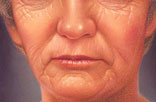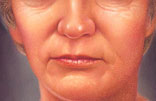

If You're Considering Laser Resurfacing... Laser resurfacing is still a very new procedure. However, it has been shown that in some cases, this surgical method produces less bleeding, bruising and post-operative discomfort than is typically seen with other resurfacing methods. A Word About the Laser It's clear that laser resurfacing may offer a number of advantages over other resurfacing methods: precision, little (if any) bleeding and less post-operative discomfort. However, laser resurfacing isn't for everyone. In some cases, an alternative skin resurfacing treatment, such as dermabrasion or chemical peel, may still be a better choice. All resurfacing treatments work essentially the same way. First, the outer layers of damaged skin are stripped away. Then, as new cells form during the healing process, a smoother, tighter, younger-looking skin surface appears. Laser resurfacing is a new method being used by plastic surgeons to remove damaged skin. Because it is new, there are no long-term data on this technique. However, a number of studies using microscopic examination have shown that the physical changes that occur to laser-treated skin are essentially identical to those that occur with either dermabrasion or chemical peel. Ask your plastic surgeon about the latest facts concerning long-term follow-up. For superficial or medium resurfacing, the laser can be limited to the epidermis and papillary dermis. For deeper resurfacing, the upper levels of the reticulas dermis can also be removed. Varied penetration allows treatment of specific spots or wrinkles. It's also important to consider the length of recovery when choosing among the skin-resurfacing alternatives. In general, the more aggressive the resurfacing procedure is, the more prolonged the recovery is likely to be. "Light" resurfacing procedures, such as superficial chemical peels or superficial laser resurfacing, offer shorter recovery times. However, these lighter procedures may need to be repeated multiple times to achieve results comparable to those achieved with more aggressive techniques. The Best Candidates For Laser Resurfacing Patients with olive skin, brown skin or black skin may be at increased risk for pigmentation changes no matter what type of resurfacing method is recommended. Your plastic surgeon will evaluate your skin characteristics and make recommendations accordingly. Also, individuals who have taken accutane in the past 12-18 months or are prone to abnormal (keloid-like) scarring or those with active skin infections on the treatment area may not be appropriate candidates for this procedure. Remember, having laser resurfacing can help enhance your appearance and your self-confidence, but it won't completely remove all facial flaws or prevent you from aging. Lines that occur as a result of natural movements of the face - smiling, squinting, blinking, talking, chewing - will inevitably recur. Your plastic surgeon can suggest ways to help you preserve your results by protecting yourself from sun exposure or using maintenance treatments, such as light chemical peels or medicated facial creams. Before you decide to have laser resurfacing, think carefully about your expectations and discuss them with your surgeon. The Procedure When the imperfections are especially deep, your surgeon may recommend that the resurfacing be performed in two or more stages. During the procedure, the activated laser is carefully passed back and forth over the skin until the surgeon reaches the level that will make the wrinkle or scar less visible. When the procedure is over, your surgeon may choose to treat the resurfaced skin with applications of protective creams or ointments until healing is complete. Some surgeons choose to apply a bandage over the treated areas which will cover and protect the healing skin for the first five to ten days.
|
 |
| Laser resurfacing is performed to improve fine wrinkled skin. |
 |
| When healing is complete, the face has a more youthful appearance. |
 |
| Within about five weeks after treatment, the upper lip is noticeably smoother. |
© 2007
The Avon Center for Aesthetic Surgery. All rights reserved.